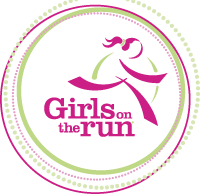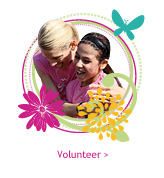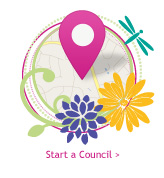National Evaluation
Girls on the Run International has evaluated program efficacy since 2002. Several preliminary descriptive and quasi-experimental studies have been conducted since that time—specific information and findings are included in the evaluation reports.
In 2014, we identified a need to update our evaluation measures that have been ongoing for almost a decade. In collaboration with our faculty research consultant (Dr. Maureen Weiss, University of Minnesota) we sought age-appropriate measures that are more closely aligned with the positive youth development framework and specifically the 5Cs + 1 (competence, confidence, connection, character, caring and contribution). As part of the process in determining the suitability of our newly chosen measures, in 2014 we conducted a season-long assessment with 5,124 girls (ages 7-13 yrs.) participating on 270 teams across 28 councils. Girls completed measures of confidence, connection, character, and caring (Fry & Gano-Overway, 2010; Harter, 1985). Competence was measured using records of 5k completion and contribution was assessed using information from community impact projects. Because Girls on the Run is a physical activity-based youth development program, we also assessed pre- to post-season change in physical activity (number of days per week of 60 min or more of moderate activity) and sedentary behavior (number of hours per week watching TV or engaging in screen time that was not part of schoolwork) using the Youth Risk Behavior Surveillance Survey (YRBS).
Results showed that the new measures were reliable with our group of girls and that they could be administered in much less time than our past measures. We conducted the analyses with the sample of girls who scored below the national mean on each construct. Girls who started with lower scores on each construct showed statistically significant and meaningful improvements on the 5Cs + 1 and physical activity and sedentary behaviors. For the total sample, percentage improvement across constructs was 31-50.5%, whereas 55.4-74.1% of girls improved who began with lower pre-season scores. Findings provide evidence that the new measures are appropriate for evaluation going forward with girls ages 7-13 years and that Girls on the Run is having a positive impact on youth development, particularly for girls who need the program the most.
Previous reports:
2011 Academic Evaluation
2007 Academic Evaluation
2006 Academic Evaluation
2005 Academic Evaluation
2002 Academic Evaluation
Phase I: Pilot Study
A pilot assessment of Girls on the Run was implemented in 2002 using a one group pre-post-test design.[1]Girls on the Run program participants from 28 program sites (n=322) in 5 geographic areas representing a range of metropolitan areas and SES were assessed. A self-report survey including the Rosenberg Self-Esteem Scale[2], the child/adolescent version of the Silhouette Ratings Scale[3], and an adapted version of the Children’s Eating Attitudes Test (ChEAT)[4] was used to assess self-esteem, body size satisfaction, and eating attitudes and behaviors. Pre- to post-test improvements were significant (p<.05) for self-esteem, eating attitudes and behaviors, and body size satisfaction.
Phase II: Preliminary Study
Building upon the pilot study, a more expansive study was implemented in2005 using a convenience sample of 20 councils representing four geographic areas using a non-experimental, single-group pre-post- intervention design of Girls on the Run and Girls on Track (n=1034).[5, 6] Participants completed a self-report survey including the Rosenberg Self-Esteem Scale[2] to assess global self-esteem, the child/adolescent version of the Schematic Figural Scale[3] to assess body image, one question from the 2005 Youth Risk Behavior Survey[7] to assess vigorous physical activity frequency, and an adapted version of the Commitment to Physical Activity Scale (CPAS).[8] Statistically significant pre-post improvements (p>.01) occurred for self-esteem, body size satisfaction, and vigorous physical activity frequency within the last week.[9] An increase in overall commitment to PA also occurred as well as a decrease in negative attitudes towards PA. Both before and after the intervention, vigorous PA frequency was significantly correlated to PA commitment (p<0.01).[8]
When stratified by number of times participating in the program, first time participants saw significant (p<.01) gains in self-esteem, body size satisfaction, commitment to physical activity, and PA frequency. Similarly, second time participants had significant increases in self-esteem, body size satisfaction, and PA frequency. Girls who participated in the program three or more times did not show any significant changes from pre- to post-intervention.[9] When stratified by age (≤10 years old; >11 years) both groups had statistically significant pre- to post-intervention differences (p<.01) in self-esteem, body size satisfaction, and PA frequency. Older girls also had increased commitment to PA.[9] Results indicated two key findings. First, participation in the Girls on the Run and Girls on Track programs observed increases in commitment to be physically active; this is particularly important because commitment is an important determinant of long-term physical activity maintenance.[10-12]Second, findings indicated age-related differences in physical activity commitment scores. More specifically, pre-intervention commitment scores were lower among older girls compared to those ≤10 years of age. However, physical activity commitment scores significantly increased from pre- to post- intervention in 11-15 year old girls. These results are valuableas physical activity declines in girls occur as early as late elementary school. Results from this study werepresented at the annual meetings for the American Public Health Association, Eating Disorders Research Society, Society for Behavioral Medicine, and the American Academy of Health Behavior.
Phase III: Quasi-Experimental Study
A longitudinal quasi-experimental study was implemented in 2009 to evaluate Girls on the Run intervention effects among 877 participants categorized into one of three groups (never, newly, and previously exposed to the intervention). A 64-item self-report survey measured participant psychological and physical assets at three time-points. Nested random effects ANOVA models were used to compare demographic factors and psychological and physical assets between exposure groups and to compare longitudinal differences in these developmental assets. After adjustment for multiple comparisons, previous program participants had significantly higher physical activity commitment (p<.01) and physical activity levels (p<.05) at pre-intervention than never exposed. From pre- to post-intervention body image improved in never and newly exposed participants, which persisted through follow-up in the comparison group. Physical activity increased from pre-intervention to follow-up among never and newly exposed participants (all p<.05).
Phase IV: Longitudinal Study
Dr. Maureen Weiss and her graduate students are in the process of developing a rigorous and longitudinal study design to determine the effectiveness of Girls on the Run having a significant positive effect on positive youth development outcomes, including physical (activity frequency, intensity, duration), psychological (e.g., body image, self-esteem, intrinsic motivation), and social assets (e.g., positive adult and peer relationships, resistance to peer pressure to engage in risky behaviors) and health promoting behaviors and outcomes.







